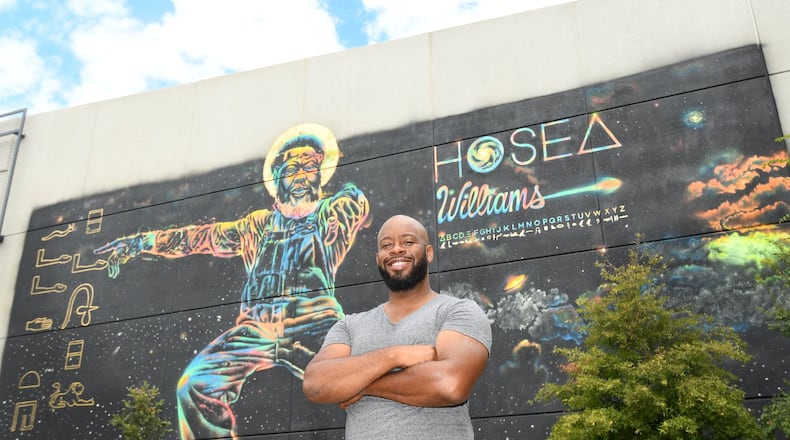Fabian Williams wants his latest mural project to spark a conversation.
The towering mural of Atlanta civil rights activist the Rev. Hosea Williams is painted on the side of a parking deck at Studioplex in the Old Fourth Ward.
“Why don’t we celebrate our civil rights heroes in a better way?” he asked. He wants people to think — and talk — about people who had made life better for others. Who marched for civil and human rights.
People like Hosea Williams.
Fabian Williams, who makes murals under the name "Occasional Superstar," was among several artists and property owners who recently sued the city of Atlanta to stop regulation of murals on private property. The city later agreed not to enforce the ordinance.
In his new mural, it may not be the image of Hosea Williams that people are used to seeing. It’s filled with symbolism.
The fluorescent mural of an overall-clad Williams is funk meets soul and blues. He’s barefoot with what appears to be a golden halo surrounding his Afro.
Williams, who’s no relation to the civil rights leader, said he wanted him barefoot because he represented “the common folks. He was humble.”
The figure’s arms are outstretched. No matter the vantage point, explained the artist, it appears that Williams is pointing at you. “He wants you to continue the work,” Williams said.
Egyptian hieroglyphs run down the left side of the mural. The key to the message is on the right, under the name Hosea Williams.
Williams wants people to decipher the message on their own.
Initially, Williams, 41, wanted to paint a mural of the Rev. Martin Luther King Jr., but was unable to get in touch with the King family.
Given the family’s well-publicized protectiveness over King’s words and image, Williams said, he decided to go another route, one that led him to Williams.
"I mainly went with Hosea Williams because I've been driving through this city since 2001 and I'd never seen a picture of him," said Williams, who was commissioned by Studioplex to do the piece. "I never knew what he looked like. I really didn't know what he did."
Sure, he’d heard about Hosea Helps, the nonprofit formerly known as Hosea Feed the Hungry & Homeless, but that was about all.
The ordained minister, scientist and trusted associate of King’s died in 2000.
Related:
Local artists paint mural to say education is “Not a Crime”
SCLC to launch hip-hop music label to engage a new generation
Artists, landowners sue city to stop regulation of murals on private property
He selected Williams out of curiosity, but the more he researched the Attapulgus, Ga.-born activist, the more he knew he was on the right track.
“He was a World War II vet. He received the Purple Heart,” said Williams, who was born in Fayetteville, N.C. “Coming back from the war, he was attacked by Klan members who jacked him up pretty bad. His new fight was against racism and poverty. I mean, he was a tough dude.”
Before he dipped his brush in paint, however, the artist sought out Williams’ family. He wanted their blessings for the project.
He explained the concept during a meeting at Hosea Helps’ offices.
He thought about putting Hosea Williams in a suit. “His family was like, nope!” said Williams. He went back and saw that Williams was often photographed in jean overalls. The mural took about two weeks to complete. He used fluorescent aerosol and acrylic with gold foil. He’s added light to really showcase the colors. It nearly pulsates off the wall.
“When you light it up, some kind of vibe comes off,” he said. “You can feel it.”
The family appears pleased as well.
"To see this mural dedicated to my father means young people have not forgotten the men and women who gave their lives to the movement for justice and righteousness and peace and love," said Elisabeth Omilami, Williams' daughter and CEO of Hosea Helps, a nonprofit formed by her parents to help the poor.
Next, Williams would love to see murals of other prominent figures who have helped shape the city and, in some cases, the world. Especially on the streets that carry their names.
Perhaps, the Rev. Ralph D. Abernathy, Williams mused.
“We have streets named after people, but there’s no visual representation,” he said. “People should know who they are.”
About the Author
The Latest
Featured



